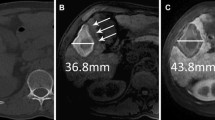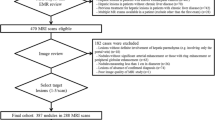Abstract.
Background: T1- and T2-weighted magnetic resonance (MR) images frequently show fan-shaped areas of hypo- or hyperintensity in the hepatic parenchyma adjacent to a treated hepatocellular carcinoma after percutaneous ethanol injection (PEI) therapy. These areas correspond to abnormal contrast enhancement on serial dynamic MR images. The purpose of the present study was to describe the location, appearance, and frequency of these abnormalities because it is important to understand these entities for the correct assessment of therapeutic efficacy.
Methods: MR imaging including a multisection dynamic study was performed in 20 consecutive patients with hepatocellular carcinoma treated with PEI therapy. We retrospectively evaluated the presence of fan-shaped hypointensities adjacent to treated tumors in the liver parenchyma on T1-weighted images and hyperintensities on T2-weighted images and corresponding fan-shaped contrast enhancement on both arterial-dominant and delayed-phase dynamic MR images. We review the location, appearance, and frequency of these findings, and we discuss the possible causes on the basis of pathologic examinations.
Results: Seven (35%) of the 20 patients showed fan-shaped hyperintense areas adjacent to the treated tumors on T2-weighted images. These areas showed isointensity in five patients and hypointensity in two patients on T1-weighted images. Of these seven patients, one (14%) underwent the MR imaging within 1 month after the completion of PEI therapy, and six (86%) had it 2–9 months after the completion of PEI therapy (mean = 6 months). In all seven patients, fan-shaped hyperperfusion abnormalities corresponding to these areas of hyperintensity on T2-weighted images were seen on both arterial-dominant and delayed-phase dynamic MR images. Pathologically, the coagulative necrosis of the hepatocytes with sinusoidal dilatation and the restoration by the development of fibrous tissue were seen in these fan-shaped areas.
Conclusion: The fan-shaped areas of abnormal intensity on T1- and T2-weighted images and contrast enhancement on dynamic MR images seem to be attributable to pathologic changes in the normal liver parenchyma induced by the toxic reaction of ethanol. Awareness of the occurrence of such abnormalities in the peripheral liver parenchyma adjacent to the treated tumor is important for the correct assessment of therapeutic efficacy. RID=""ID=""<e5>Correspondence to:</e5> T. Fujita
Similar content being viewed by others
Author information
Authors and Affiliations
Additional information
Received: 24 June 1997/Accepted after revision: 22 October 1997
Rights and permissions
About this article
Cite this article
Fujita, T., Honjo, K., Ito, K. et al. Fan-shaped hepatic parenchymal damage after ethanol injection therapy for hepatocellular carcinoma: MRI appearances. Abdom Imaging 24, 56–60 (1999). https://doi.org/10.1007/s002619900440
Issue Date:
DOI: https://doi.org/10.1007/s002619900440




